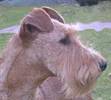|
|
Health Testing
Cystinuria in Irish Terriers The truth is that Irish Terriers are a very healthy breed of dog having only two heritable problems that have been known about for a very very long time. These problems are Corny Feet (Hyperkeratosis) and When I entered the world of Irish Terriers, in the early 1980’s I knew of both of these problems. I understood that Corny Feet (CF for short) would present with deep cracks in the foot pad and also excessive skin growths (like extra toes almost). This condition, if present would be easy to pick as it would be very visual. I really didn’t know much about So here we are in the year 2010, quite a few years from the 1980’s!!!! To the best of my knowledge my breeding lines are clear of Corny Feet, in fact this is a condition that I have not personally heard of in What about Cystinuria (CU), well the news on that front is not all good nor is it all bad but before we go further I would like to go into more detail about the condition for you. Cystine is a naturally occurring Amino Acid made by the body and reabsorbed to support the cells that make hair, skin and nails. In dogs (humans and other creatures) that have the disease known as Cystinuria the cystine is not fully reabsorbed, the excess filters into the urine in high levels. The danger of high cystine in the urine is that it can form crystals which are painful to pass and cause inflammation and irritation or, in the worst cases, form stones which block the passing of urine. In terms of conditions or diseases that dogs could inherit this one is nowhere near as bad as most. In fact, with proper testing and treatment dogs will live a normal life. It is fair to say that most owners would never know their dogs have Cystinuria as it is almost never present in females and risk in males is greatly reduced if the dog is castrated, which is pretty well routine in Australia. Humans,
Frequently Asked Questions
Do dogs in Australia have this disease? Yes, early testing has shown that there are a number of dogs in Australia with this condition. They come from a wide array of bloodlines. Testing also shows that many dogs seem to be unaffected also.
Does it affect males and females? Present information in Irish Terriers indicates that some males are affected by high levels of cystine, it is very rare that females are (this is one of the reasons that makes this disease different to the Type 1 found in Mode of inheritance? This has not yet been established, more testing needs to be done to support the research into finding the mutant gene that causes this disease. It is widely considered (by scientists) that the gene might be sex linked and carried by females (this is supported by our observations in How do I know if my dog has the condition? At the moment the only way to determine if your dog has cystinuria is by urine analysis. Even if your dog has been unlucky enough to form stones (or crystals) these need to be analysed to show if they are from cystine as there are many reasons why stones can form. What can happen if stones form? This is a very serious situation and if not addressed quickly can be fatal to the dog. First symptoms might be frequency in urination, difficulty passing urine, blood in the urine, pain and discomfort. There have been deaths in Irish Terriers from this condition. Is the condition dangerous or fatal? Yes, it is very dangerous and can be fatal, get to your vet fast. What can I do to protect my dog? Dr Giger is conducting more research into the impact of castration on affected males. It appears that castrating males reduces the levels of cystine dramatically. A vast majority of pet owners in How does diet affect the condition? In May 2010 Dr Giger, who is a leader in the research of CU, gave a lecture in Does the water that dogs are drinking have any impact on the results? No, water does not contain cystine. Will feeding supplements affect the results? Feeding vitamin C can affect the COLA test (as it changes the property of cystine to cystien) but it will NOT affect the Nitroprusside test. What age should I test? We asked Dr Giger this question in May 2010. His response was that dogs as early as a few months could be tested but he recommended waiting until they were at least 12 months old. What tests should be done? We recommend that at least a Nitroprusside test be done to determine if your dog has cystine. You can also have a COLA test conducted and this is recommended in positive cystine tests to give a more complete picture of the amounts of cystine? Are the tests conclusive? If the Nitroprusside test comes back as positive then yes, your dog has cystine in the urine and it is conclusive but it is always recommended to retest to be absolutely sure in your own mind or that you follow up with a COLA test. There is not the same degree of certainty in negative tests and it is recommended to retest these dogs if you have doubts or reason to be concerned (such as affected parents, urinary tract problems etc) What about dogs related to affected dogs? Testing related males (sires, brother, sons) with a nitroprusside test will give a good indication of whether your dog has cystine and is affected. As results from females are not likely to show a positive result to Nitroprusside then we can only assume that related females (daughter, sister etc) are carriers. This is the safest option for the breed at this point in time. Once a Will sending samples via the post put the samples at risk? We have posted samples from as far away as My Irish Terrier is only a pet, should I test it? If you have concerns you should discuss these with your vet. If you have a male we would urge you to sterilise him (as should be recommended by your breeder), once sterilised then there is little need for you to test. Who does the testing? Exhaustive research could not find an accredited lab in Is there panic or hysteria amongst breeders? We do not believe so. The only way to be informed about your breeding stock is to have them tested. If we do not test then we are breeding without all possible information being taken into account and to many of us this is not acceptable. The vast majority of breeders in
Neridah Sharrett Canning Vale, WA, Australia Phone : 08 9455 1059 Email : [email protected] |

